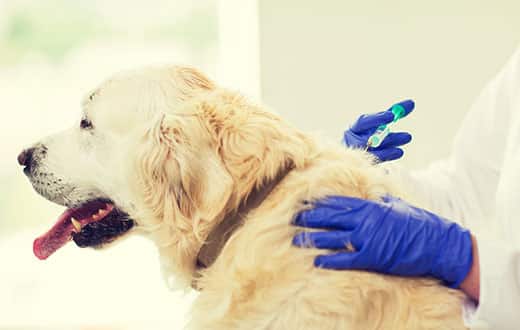

Rabies is a word that can — and should — elicit concern: it's a highly contagious disease that both dog and cat parents should not ignore. As a fatal virus that kills nearly 60,000 people worldwide on a yearly basis, according to the CDC, it presents concerns for you and your family as well. Even dog owners in urban environments should learn the signs of rabies in dogs. Cats are certainly not exempt from the perils of contracting rabies, as they are the domestic animal most frequently diagnosed with rabies in the U.S., explains the American Veterinary Medical Association. This may be due to less stringent local laws surrounding rabies vaccinations for cats than dogs.
The Rabid Dog: How Does a Dog Get Rabies?
Rabies is found in many species of wildlife — with breeding grounds of infection in bats, skunks, foxes and raccoons. As human populations grow and encroach further onto undeveloped land, the exposure risk increases for dogs and people.
Rabies can be passed from any infected warm-blooded animal to another, most often through the bite of an infected animal, though scratches pose a small possibility of transmission.

How is Rabies Transmitted to Humans?
Rabies is transmitted to humans almost entirely through bites from rabid animals, although contamination of open wounds or mucous membranes with saliva from a rabid animal could potentially cause exposure.
Each year in the U.S., between 30,000 and 60,000 people seek post-exposure treatment, according to the CDC. The good news is that treatment for people is very effective when it is initiated quickly. Don't take this as an excuse to let your guard down around this virus. Once the rabies virus reaches the nervous system, there is no cure, making prompt medical care a life-saving necessity.
The best way to protect yourself and your dog from the dangers of the rabies virus is to vaccinate your dog against rabies. Rabies is very preventable!
What are the Symptoms of Rabies in Dogs?
A rabies infection occurs in phases, first causing a variety of marked changes in temperament. There are no strict rules for this phase, but a dog with a sudden personality change is a clue that rabies may be responsible.
Following this temperament change, there are two recognized forms of rabies:
- Furious rabies is typically characterized by the dog having a voracious appetite, even eating nonfood items such as stones and dirt. The dog eventually will become paralyzed, unable to eat or drink. Death usually follows violent seizures.
- Dumb or paralytic rabies is the form in dogs people often associate with salivating, rabid dog imagery. This form involves progressive paralysis as well. The dog's face may distort and swallowing may appear to be a struggle. For this reason, you should exercise caution around any animal that appears to have something stuck in its mouth or throat. Attempting to pry the mouth open of an infected animal can result in the transmission of rabies. With dumb rabies, the dog lapses into a coma and death follows.
Did you know? Fear of water is not a sign of rabies in dogs but is instead a sign of rabies in people.
How Long Does It Take for Rabies to Develop?
The incubation period, or the amount of time from bite to clinical signs of rabies, can vary from mere days to six months or more. In dogs, this period is typically two weeks to four months, with death occurring one to two weeks after signs begin.
The speed at which signs of rabies in dogs develops varies if the dog has any existing immunity to the virus (such as a previous, even outdated vaccine or immunity passed down from the mother) and the bite itself. Severe and extensive bites typically transmit more of the virus, accelerating the period from infection to clinical signs.

What Is the Treatment for a Dog With Rabies?
Sadly, there is no available treatment for a rabid dog. Veterinarians are required by law to notify the local and state animal disease regulatory authorities. If a dog was previously vaccinated, the vet will likely recommend a prompt booster of the rabies vaccine.
Vaccinations & Preventing Rabies in My Dog
- Take pets to a vet or vaccine clinic for a rabies vaccine. Vaccines are available for dogs, cats, and even ferrets. Keeping your dog's vaccinations are essential for keeping them from getting rabies, but they are also required by law.
- Avoid contact with wildlife under all circumstances, dead or alive. Animals can shed the virus through saliva up to two weeks before any signs of rabies begin and can remain in the body's tissues shortly after death.
- Minimize the chance your pets will have contact with wildlife. Keep your dogs on leashes and supervise them when outdoors. Covering outdoor garbage will help avoid attracting wildlife. Rabies is a public health concern, and resources are in place to help keep wildlife away from our domestic pets. Call animal control when you notice stray animals or wildlife.
If given before the virus enters the dog's nervous system, rabies vaccines are extremely safe and effective. Despite good measures to avoid exposure, though, contact with rabid animals can still occur. Remember, animals infected with the rabies virus shed the virus before any abnormal signs of illness occur, making vaccination for your pets crucial.
If you suspect your dog may have been exposed to rabies, bring them to a vet immediately. If your dog is unprotected against rabies, there is no time like the present to schedule a vet appointment.




















